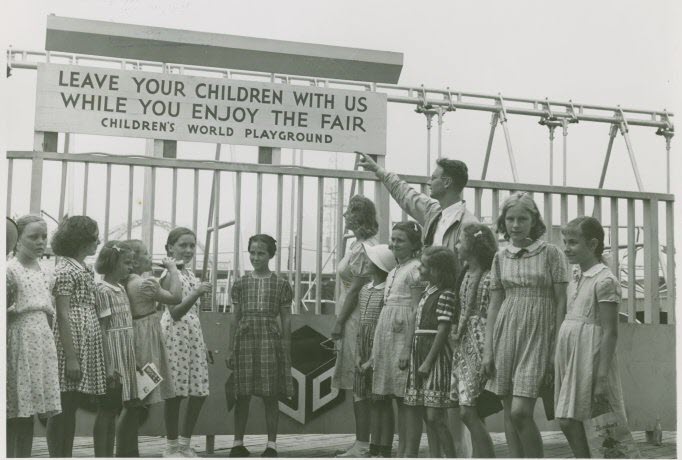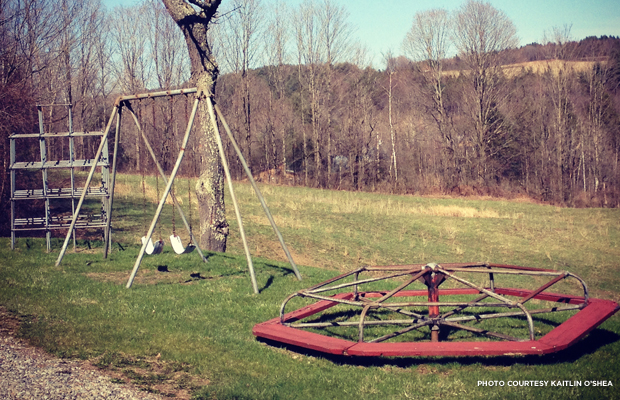From Vacant Lots to Modern Marvels, Playgrounds Have Come a Long Ways

Entrance of Children’s World Playground, part of the 1939 World’s Fair in New York, | Image via NYPL.org
It is relatively easy to conjure memories of days spent following the lead of our own imagination as we played on the neighborhood playground equipment. We soared into the air, climbed our way to triumph, raced down the slide and then back again to its top, and spun ourselves silly in the euphoria produced by it all. We also interacted with our peers, solved intractable problems, and increased physical ability. Many of us first met lifelong friends and even spouses during long afternoons at play. With such ubiquity, it is easy to believe that thoughtfully constructed playgrounds were always an important aspect of every neighborhood’s development and construction. The truth is that the development of dedicated plays spaces with safe and accessible playground equipment may not have occurred without the work of dedicated individuals, multiple groups, and even a boost from The President of the United States.
An Emerging Consensus on Play
The spaces Americans first played in had no equipment. They were empty rural fields and converted urban alleys, giving rise to the term ‘sandlot’ or ‘sand garden.’ In these early playgrounds, children often organized themselves. As the country industrialized and our cities grew in size, such unsupervised activity came to be seen as cause for concern. In response, play became increasingly organized by adults and was viewed as a means of guiding children along a path towards good health and good citizenship. Jane Addams’ Hull House and the YMCA are representative of the types of organizations that emerged to advocate for and eventually study the benefits of playgrounds.
The Playground Idea Catches Hold
San Francisco’s Golden Gate Park opened the country’s first playground in 1887. A little over a decade later, the Playground Association of America was founded in 1906. Beginning in Boston, the association saw itself and the playgrounds it advocated for as a means of integrating the children of immigrants and providing all children with moral instruction. At the association’s first meeting they elected Theodore Roosevelt as their honorary President, who provided much-needed early support, stating in 1907:
City streets are unsatisfactory playgrounds for children because of the danger, because most good games are against the law, because they are too hot in summer, and because in crowded sections of the city they are apt to be schools of crime. Neither do small back yards nor ornamental grass plots meet the needs of any but the very small children. Older children who would play vigorous games must have places especially set aside for them; and, since play is a fundamental need, playgrounds should be provided for every child as much as schools. This means that they must be distributed over the cities in such a way as to be within walking distance of every boy and girl, as most children can not afford to pay carfare.
Trained instructors, organized sports, and hand-made equipment dominated playground construction in the early 20th century. Soon though, much of what we consider iconic playground equipment began to emerge.
Metal Structures and Simple Designs
Socialization and physical health were the two primary goals of early playground design, so was equipment that could be created or put-together by hand. Often times, playground equipment was even deconstructed and stored for Winter. Early playgrounds typically consisted of bars in various formations to encourage physical activity, equipment that required more than one child to operate (i.e. see-saws and merry-go-rounds), and swings of various types for fun and socialization. Even as early playground equipment became increasingly available, most play activities were still organized and directed by adults. Making the use of these early playgrounds far different from what is experienced today.
Novel Playgrounds Encourage Adventure
Beginning in the 1950’s, playground equipment moved from hand-made construction, or that assembled from pre-made kits, to more elaborate and standardized creations. The benefits of playgrounds were well-established and larger firms specializing in designing, building, and maintaining playground equipment began to emerge. Beyond merely providing a means for children to develop their physical and mental abilities, playground equipment actively took on the role of boosting that development without the need for adult intervention. Instead of adults organizing play activities for specific purposes, the equipment itself encouraged healthy participation and social interaction. This freed children to follow their creative impulses. Safety, however, still remained a secondary-thought. Soon though, playground equipment constructed of hard metal with sharp edges, built on tough ground if not concrete itself, and with little thought to the consequences of inevitable falls, began to be replaced with the safer designs we expect children to enjoy today.
Safe, Inclusive, and Beneficial to Kids of All Ages
Today’s playground equipment builds on the legacy of those early advocates from over a century ago. With an improved understanding on how playgrounds benefit entire communities, modern playground equipment is designed to serve as the social center for whole neighborhoods. Every age and ability-level is welcome to enjoy the benefits of modern playground design. Playground equipment now has soft rounded edges and the hard ground has been replaced with a variety of more forgiving materials. Incorporating natural landscapes and an emerging focus on sustainable design promises even more fun-filled advances as playground equipment continues to evolve. What will always stay the same for every playground is their ability to engage our imagination and encourage us to succeed beyond all perceived limitations.





 RSS Feed
RSS Feed
Recent Comments